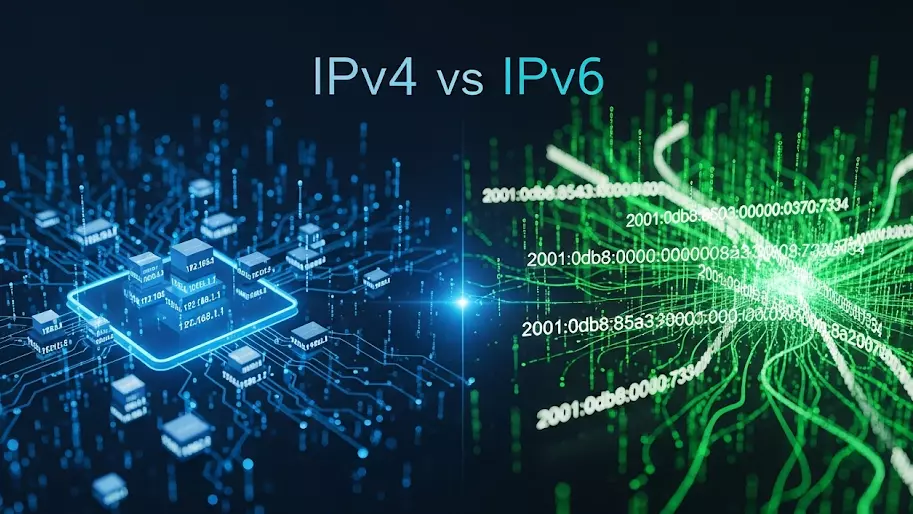As internet technology continues to evolve, the transition from IPv4 to IPv6 is becoming increasingly important for businesses, network engineers, and anyone who manages online infrastructure. The world of IP addresses—the unique identifiers that devices use to communicate over the internet—is shifting. IPv4, the original system, has run out of address space, while IPv6 offers an almost infinite number of unique addresses.
In this ultimate guide, we will cover the key differences between IPv4 and IPv6, the benefits of migrating to IPv6, the role of proxies in this transition, and best practices for navigating the shift.

What Are IPv4 and IPv6?
The Internet Protocol (IP) is the foundation of how devices communicate across the web. Every device—be it a computer, smartphone, or IoT appliance—needs an IP address to send and receive data. The two most widely used versions of the Internet Protocol are:
- IPv4: Introduced in 1981, IPv4 uses a 32-bit address scheme, allowing for roughly 4.3 billion unique IP addresses. This format is written in dotted decimal notation (e.g.,
192.168.0.1). - IPv6: Introduced in 1998 as a solution to the shortage of IPv4 addresses, IPv6 uses a 128-bit address space, providing a virtually limitless number of IP addresses—around 340 undecillion addresses. IPv6 addresses are written in hexadecimal, such as
2001:0db8:85a3:0000:0000:8a2e:0370:7334.
IPv6 is not a replacement for IPv4, but rather a complement. Both systems will coexist for some time, with many networks adopting dual-stack configurations that support both IPv4 and IPv6.
Key Differences Between IPv4 and IPv6
To better understand how these protocols differ, let’s dive deeper into the technical distinctions between IPv4 and IPv6:
| Feature | IPv4 | IPv6 |
| Address Length | 32-bit (~4.3 billion addresses) | 128-bit (~3.4 × 10^38 addresses) |
| Notation | Decimal, dot-separated (e.g., 192.168.1.1) | Hexadecimal, colon-separated (e.g., 2001:0db8::1) |
| NAT Requirement | Yes (due to address scarcity) | No (supports direct end-to-end communication) |
| Security | Optional (IPSec added later) | Built-in IPSec support |
| Header Efficiency | More complex (higher processing cost) | Simplified, more efficient header design |
| Auto Configuration | DHCP (Dynamic Host Configuration Protocol) | SLAAC (Stateless Address Autoconfiguration) |
| Multicast Support | Limited | Native support (no broadcast) |
The Benefits of IPv6 Over IPv4
IPv6 was created to address several limitations in IPv4, providing a host of advantages that are increasingly critical in the modern internet landscape:
- Larger Address Space: The most obvious benefit of IPv6 is the near-infinite number of available IP addresses. This is vital for a world where billions of devices (from smartphones to smart refrigerators) need unique identifiers.
- Simplified Network Configuration: IPv6 eliminates the need for Network Address Translation (NAT), which is commonly used in IPv4 networks to compensate for the limited address space. With IPv6, each device can have its own unique IP, making direct communication between devices easier.
- Improved Security: IPv6 has security features like IPSec built into the protocol itself. Although IPSec can be used with IPv4, it is optional, whereas with IPv6, it’s mandatory, ensuring that data is encrypted and authenticated during transmission.
- Better Routing Efficiency: IPv6 reduces the size of routing tables, helping internet traffic flow more efficiently and reducing network congestion.
- Future-Proofing: As the number of connected devices continues to grow, IPv6 provides the scalability needed to handle the explosion of IoT devices, autonomous vehicles, and new technologies that require unique IP addresses.
Why IPv6 Adoption is Critical for the Future
While IPv4 still dominates the internet, its limitations are increasingly becoming a bottleneck. The continued global IP address exhaustion has made it clear that IPv6 adoption is not just beneficial but necessary for the future of the internet. With IoT, smart cities, and 5G networks on the horizon, IPv6’s ability to scale to an almost infinite number of devices is essential.
As IPv6 adoption increases, more websites, ISPs, and cloud providers are enabling support for IPv6. However, the migration to IPv6 is gradual, and many networks still rely heavily on IPv4. That’s where dual-stack environments—where both IPv4 and IPv6 run simultaneously—become crucial in ensuring seamless communication across all internet-connected devices.
How Proxies Fit Into IPv4 and IPv6 Networks

Proxies play a vital role in managing internet traffic, whether through IPv4 or IPv6 networks. A proxy acts as an intermediary server that routes requests between a client (e.g., a user or application) and the destination server. In both IPv4 and IPv6 environments, proxies are essential for:
- Anonymity and Privacy: Proxies can hide the user’s real IP address, preventing websites from tracking their location and behavior.
- Security: Proxies can filter out malicious content, block unwanted websites, and prevent cyberattacks.
- Bypassing Geo-restrictions: Proxies allow users to access content that is geographically restricted by masking the user’s real location.
- Traffic Management: Proxies can distribute network traffic more efficiently, load-balance servers, and reduce bottlenecks.
IPFLY’s proxy services support both IPv4 and IPv6, giving businesses the flexibility to manage traffic seamlessly across both protocols. Whether using datacenter proxies, ISP proxies, or residential proxies, IPFLY ensures that businesses have the right tools to scale and maintain secure, anonymous, and reliable network operations.
Real-World Use Cases for IPv4 and IPv6 Proxies
Both IPv4 and IPv6 proxies have their place in various industries, particularly for:
- SEO and Digital Marketing: Rotating proxies allow businesses to gather large amounts of data from search engines, competitors, or social media platforms without risking IP bans. IPv6 proxies are particularly useful here as they provide a vast pool of unique addresses, which reduces the chances of detection.
- E-commerce: Price tracking and web scraping are critical for competitive analysis in the e-commerce space. Proxies allow businesses to monitor product prices and stock levels without revealing their own IP addresses. IPv6 proxies are particularly beneficial as they offer more IP addresses, reducing the chances of IP blocks.
- Web Scraping and Data Collection: Large-scale data scraping operations often use proxies to avoid IP bans. IPv6 proxies make this process more efficient due to their larger address space, while IPv4 proxies are still used widely in many legacy systems.
How to Migrate from IPv4 to IPv6: A Step-by-Step Guide
The process of migrating from IPv4 to IPv6 can be complex, but with the right approach, it can be smooth. Here’s a general guide for the migration:
- Assess Your Network: Identify devices, servers, and services that need IPv6 support. Start by enabling IPv6 on the most critical infrastructure.
- Enable Dual-Stack: For most organizations, the best approach is to run dual-stack systems where both IPv4 and IPv6 are supported. This allows a gradual transition without interrupting services.
- Update Network Infrastructure: Make sure routers, switches, and firewalls are IPv6-capable. You may need to upgrade certain hardware or software.
- Test IPv6 Performance: Monitor the performance of your IPv6 network. Look for any compatibility issues and address them as they arise.
- Deploy Proxies: Ensure that your proxy solutions support both IPv4 and IPv6 to ensure global access and seamless traffic management.
IPv4 vs IPv6 in Business Operations
For businesses, the choice of IPv4 or IPv6 impacts everything from network management to customer engagement:
- IPv4 is still widely used, especially in legacy systems. If you’re using IPv4 proxies, it’s essential to ensure that your network is equipped to handle the increasing demand for IPv6 compatibility.
- IPv6 opens the door to more scalable, future-proof infrastructure. Migrating to IPv6 is an investment in long-term business growth, enabling greater reach and more efficient operations.
By ensuring your network is compatible with both protocols, you position your business to thrive in a digital landscape that is increasingly powered by IPv6.
Challenges and Best Practices for Migration
The migration to IPv6 presents several challenges, including:
- Legacy Software Compatibility: Older systems and software may not support IPv6, requiring updates or replacements.
- Training and Knowledge: Your IT team will need to learn about IPv6 protocols and how to troubleshoot IPv6-related issues.
- Security Concerns: IPv6 is inherently secure, but it’s still susceptible to misconfigurations and cyberattacks. Ensure that your firewalls and security protocols are updated for IPv6.
Best practices for a smooth migration:
- Start with testing: Run a small pilot using IPv6 before rolling it out to your entire infrastructure.
- Use Dual-Stack Configuration: This ensures that you can run both IPv4 and IPv6 concurrently, providing flexibility during the transition.
- Leverage Proxies: Using proxies that support both IPv4 and IPv6 ensures uninterrupted services as you migrate.
Conclusion

As the internet grows, so too does the need for more IP addresses. While IPv4 has served us well for decades, IPv6 is the future, offering the scalability, efficiency, and security required for tomorrow’s internet.
At IPFLY, we support businesses through both IPv4 and IPv6 with our comprehensive proxy solutions. Whether you need residential, datacenter, or ISP proxies, our services are designed to help you scale seamlessly while ensuring security, privacy, and performance.
Keep learning and exploring—follow IPFLY on Telegram today.


